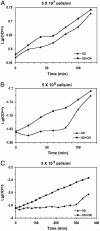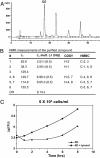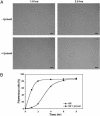Tyrosol is a quorum-sensing molecule in Candida albicans
- PMID: 15051880
- PMCID: PMC387371
- DOI: 10.1073/pnas.0401416101
Tyrosol is a quorum-sensing molecule in Candida albicans
Abstract
The human fungal pathogen Candida albicans shows a significant lag in growth when diluted into fresh minimal medium. This lag is abolished by the addition of conditioned medium from a high-density culture. The active component of conditioned medium is tyrosol, which is released into the medium continuously during growth. Under conditions permissive for germ-tube formation, tyrosol stimulates the formation of these filamentous protrusions. Because germ-tube formation is inhibited by farnesol, another quorum-sensing molecule, this process must be under complex positive and negative control by environmental conditions. The identification of tyrosol as an autoregulatory molecule has important implications on the dynamics of growth and morphogenesis in Candida.
Figures





References
Publication types
MeSH terms
Substances
Associated data
- Actions
Grants and funding
LinkOut - more resources
Full Text Sources
Other Literature Sources

